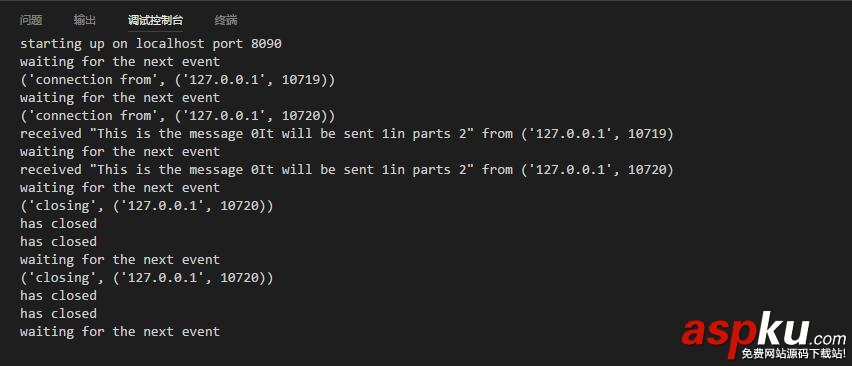要理解select.select模塊其實(shí)主要就是要理解它的參數(shù), 以及其三個(gè)返回值。
select()方法接收并監(jiān)控3個(gè)通信列表, 第一個(gè)是所有的輸入的data,就是指外部發(fā)過(guò)來(lái)的數(shù)據(jù),第2個(gè)是監(jiān)控和接收所有要發(fā)出去的data(outgoing data),第3個(gè)監(jiān)控錯(cuò)誤信息在網(wǎng)上一直在找這個(gè)select.select的參數(shù)解釋, 但實(shí)在是沒(méi)有, 哎...自己硬著頭皮分析了一下。
readable, writable, exceptional = select.select(inputs, outputs, inputs)
第一個(gè)參數(shù)就是服務(wù)器端的socket, 第二個(gè)是我們?cè)谶\(yùn)行過(guò)程中存儲(chǔ)的客戶端的socket, 第三個(gè)存儲(chǔ)錯(cuò)誤信息。
重點(diǎn)是在返回值, 第一個(gè)返回的是可讀的list, 第二個(gè)存儲(chǔ)的是可寫(xiě)的list, 第三個(gè)存儲(chǔ)的是錯(cuò)誤信息的list。
這個(gè)也不必深究, 看看代碼自己分析下就能有大概理解。
網(wǎng)上所有關(guān)于select.select的代碼都是差不多的, 但是有些不能運(yùn)行, 或是不全。我自己重新寫(xiě)了一份能運(yùn)行的程序, 做了很多注釋, 好好看看就能搞懂
服務(wù)器端:
# coding: utf-8import selectimport socketimport Queuefrom time import sleep# Create a TCP/IPserver = socket.socket(socket.AF_INET, socket.SOCK_STREAM)server.setblocking(False)# Bind the socket to the portserver_address = ('localhost', 8090)print ('starting up on %s port %s' % server_address)server.bind(server_address)# Listen for incoming connectionsserver.listen(5)# Sockets from which we expect to readinputs = [server]# Sockets to which we expect to write# 處理要發(fā)送的消息outputs = []# Outgoing message queues (socket: Queue)message_queues = {}while inputs: # Wait for at least one of the sockets to be ready for processing print ('waiting for the next event') # 開(kāi)始select 監(jiān)聽(tīng), 對(duì)input_list 中的服務(wù)器端server 進(jìn)行監(jiān)聽(tīng) # 一旦調(diào)用socket的send, recv函數(shù),將會(huì)再次調(diào)用此模塊 readable, writable, exceptional = select.select(inputs, outputs, inputs) # Handle inputs # 循環(huán)判斷是否有客戶端連接進(jìn)來(lái), 當(dāng)有客戶端連接進(jìn)來(lái)時(shí)select 將觸發(fā) for s in readable: # 判斷當(dāng)前觸發(fā)的是不是服務(wù)端對(duì)象, 當(dāng)觸發(fā)的對(duì)象是服務(wù)端對(duì)象時(shí),說(shuō)明有新客戶端連接進(jìn)來(lái)了 # 表示有新用戶來(lái)連接 if s is server: # A "readable" socket is ready to accept a connection connection, client_address = s.accept() print ('connection from', client_address) # this is connection not server connection.setblocking(0) # 將客戶端對(duì)象也加入到監(jiān)聽(tīng)的列表中, 當(dāng)客戶端發(fā)送消息時(shí) select 將觸發(fā) inputs.append(connection) # Give the connection a queue for data we want to send # 為連接的客戶端單獨(dú)創(chuàng)建一個(gè)消息隊(duì)列,用來(lái)保存客戶端發(fā)送的消息 message_queues[connection] = Queue.Queue() else: # 有老用戶發(fā)消息, 處理接受 # 由于客戶端連接進(jìn)來(lái)時(shí)服務(wù)端接收客戶端連接請(qǐng)求,將客戶端加入到了監(jiān)聽(tīng)列表中(input_list), 客戶端發(fā)送消息將觸發(fā) # 所以判斷是否是客戶端對(duì)象觸發(fā) data = s.recv(1024) # 客戶端未斷開(kāi) if data != '': # A readable client socket has data print ('received "%s" from %s' % (data, s.getpeername())) # 將收到的消息放入到相對(duì)應(yīng)的socket客戶端的消息隊(duì)列中 message_queues[s].put(data) # Add output channel for response # 將需要進(jìn)行回復(fù)操作socket放到output 列表中, 讓select監(jiān)聽(tīng) if s not in outputs: outputs.append(s) else: # 客戶端斷開(kāi)了連接, 將客戶端的監(jiān)聽(tīng)從input列表中移除 # Interpret empty result as closed connection print ('closing', client_address) # Stop listening for input on the connection if s in outputs: outputs.remove(s) inputs.remove(s) s.close() # Remove message queue # 移除對(duì)應(yīng)socket客戶端對(duì)象的消息隊(duì)列 del message_queues[s] # Handle outputs # 如果現(xiàn)在沒(méi)有客戶端請(qǐng)求, 也沒(méi)有客戶端發(fā)送消息時(shí), 開(kāi)始對(duì)發(fā)送消息列表進(jìn)行處理, 是否需要發(fā)送消息 # 存儲(chǔ)哪個(gè)客戶端發(fā)送過(guò)消息 for s in writable: try: # 如果消息隊(duì)列中有消息,從消息隊(duì)列中獲取要發(fā)送的消息 message_queue = message_queues.get(s) send_data = '' if message_queue is not None: send_data = message_queue.get_nowait() else: # 客戶端連接斷開(kāi)了 print "has closed " except Queue.Empty: # 客戶端連接斷開(kāi)了 print "%s" % (s.getpeername()) outputs.remove(s) else: # print "sending %s to %s " % (send_data, s.getpeername) # print "send something" if message_queue is not None: s.send(send_data) else: print "has closed " # del message_queues[s] # writable.remove(s) # print "Client %s disconnected" % (client_address) # # Handle "exceptional conditions" # 處理異常的情況 for s in exceptional: print ('exception condition on', s.getpeername()) # Stop listening for input on the connection inputs.remove(s) if s in outputs: outputs.remove(s) s.close() # Remove message queue del message_queues[s] sleep(1)客戶端:
# coding: utf-8import socketmessages = ['This is the message ', 'It will be sent ', 'in parts ', ]server_address = ('localhost', 8090)# Create aTCP/IP socketsocks = [socket.socket(socket.AF_INET, socket.SOCK_STREAM), socket.socket(socket.AF_INET, socket.SOCK_STREAM), ]# Connect thesocket to the port where the server is listeningprint ('connecting to %s port %s' % server_address)# 連接到服務(wù)器for s in socks: s.connect(server_address)for index, message in enumerate(messages): # Send messages on both sockets for s in socks: print ('%s: sending "%s"' % (s.getsockname(), message + str(index))) s.send(bytes(message + str(index)).decode('utf-8')) # Read responses on both socketsfor s in socks: data = s.recv(1024) print ('%s: received "%s"' % (s.getsockname(), data)) if data != "": print ('closingsocket', s.getsockname()) s.close()寫(xiě)代碼過(guò)程中遇到了兩個(gè)問(wèn)題, 一是如何判斷客戶端已經(jīng)關(guān)閉了socket連接, 后來(lái)自己分析了下, 如果關(guān)閉了客戶端socket, 那么此時(shí)服務(wù)器端接收到的data就是'', 加個(gè)這個(gè)判斷。二是如果服務(wù)器端關(guān)閉了socket, 一旦在調(diào)用socket的相關(guān)方法都會(huì)報(bào)錯(cuò), 不管socket是不是用不同的容器存儲(chǔ)的(意思是說(shuō)list_1存儲(chǔ)了socket1, list_2存儲(chǔ)了socket1, 我關(guān)閉了socket1, 兩者都不能在調(diào)用這個(gè)socket了)
服務(wù)器端:

客戶端:

以上這篇基于python select.select模塊通信的實(shí)例講解就是小編分享給大家的全部?jī)?nèi)容了,希望能給大家一個(gè)參考,也希望大家多多支持VEVB武林網(wǎng)。
新聞熱點(diǎn)
疑難解答
圖片精選